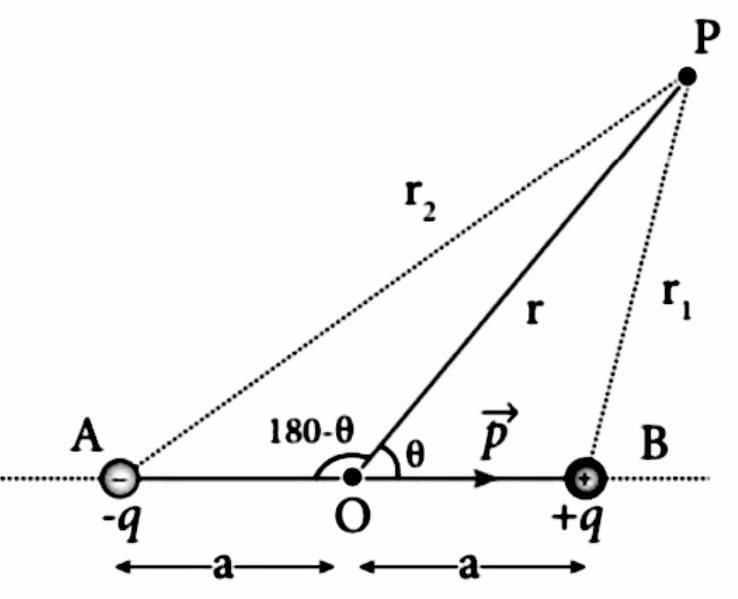
A small electric dipole is of dipole moment p. The electric potential at a distance ‘r’ from the center and making an angle
Answer
423k+ views
Hint: Electric dipole is a couple of opposite charges given by q and -q. they are separated by the distance d. In this given space the direction of the dipole is always from -q to positive charge q. In the question we need to find potential at distance r from center. It is making an angle
Formula Used:
Complete step-by-step solution:

First of all we have the dipole with charges q and -q at the ends.
The potential at the distance ‘r’ can be found out as follows:
First from the figure we will get,
Cosine formula for any triangle.
Here, z is hypotenuse.
According to our dimensions
By taking square root on both sides we get,
Now using the identity,
We get,
We know for the potential we need to find individual potentials from each charge and add them. So,
Putting the values taken found out above and solving,
Further solving the equations and neglecting a as it is very small we get
Note: Potential at the point is always an addition of potential due to all charges/dipoles. Potential negative means whatever the system is under study it is stable. If potential is positive it is an unstable system. Force varies inversely with square of the distance and potential inversely with first power of distance.
Formula Used:
Complete step-by-step solution:

First of all we have the dipole with charges q and -q at the ends.
The potential at the distance ‘r’ can be found out as follows:
First from the figure we will get,
Cosine formula for any triangle.
Here, z is hypotenuse.
According to our dimensions
By taking square root on both sides we get,
Now using the identity,
We get,
We know for the potential we need to find individual potentials from each charge and add them. So,
Putting the values taken found out above and solving,
Further solving the equations and neglecting a as it is very small we get
Note: Potential at the point is always an addition of potential due to all charges/dipoles. Potential negative means whatever the system is under study it is stable. If potential is positive it is an unstable system. Force varies inversely with square of the distance and potential inversely with first power of distance.
Recently Updated Pages
Master Class 9 General Knowledge: Engaging Questions & Answers for Success

Master Class 9 English: Engaging Questions & Answers for Success

Master Class 9 Science: Engaging Questions & Answers for Success

Master Class 9 Social Science: Engaging Questions & Answers for Success

Master Class 9 Maths: Engaging Questions & Answers for Success

Class 9 Question and Answer - Your Ultimate Solutions Guide

Trending doubts
Give 10 examples of unisexual and bisexual flowers

Draw a labelled sketch of the human eye class 12 physics CBSE

Differentiate between homogeneous and heterogeneous class 12 chemistry CBSE

Differentiate between insitu conservation and exsitu class 12 biology CBSE

What are the major means of transport Explain each class 12 social science CBSE

Why is the cell called the structural and functional class 12 biology CBSE




